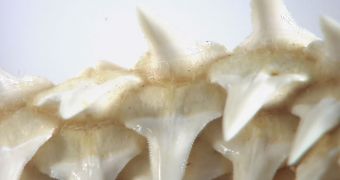Shark jaws are one the most terrible things invented by nature. But even if a Great White can be 7.2 m (24 ft) long and 3.2 tons heavy, fossils of sardine-sized fish could explain how these terrible teeth attached to their jawbones evolved.
"The fish, which lived 420 million years ago, are a "very modest" beginning for the jaw-and-tooth pattern widespread in nature today. It's really the first evidence that we have of the earliest bony fishes-the earliest ancestors of all the fishes that have the[ir] bones and teeth implanted in the bones of the jaw," said co-author Philippe Janvier, a paleontologist at the National Museum of Natural History in Paris, France.
Modern bony fishes, from herring and pikes to carps and coelacanths have this tooth arrangement, like tetrapods (four-limbed vertebrates), from frogs to reptiles (like crocodiles, snakes, lizards) and mammals, humans included, as they are all descendants of bony fishes. When a bony fish or a tetrapod loses a tooth, a new one emerges from the bone below the void, but in sharks, their teeth develop from inside their gums, being lined up in "families." Sharks form a group of fish distinct from the bony ones, called cartilagenous (they have cartilages, no bones).
New teeth develop at the inner end of their respective tooth family and old teeth fall off at the external side, like in a conveyor belt.
There are early fossils of bony fishes and sharks, but the earliest stages of jawed vertebrate evolution are very unclear. "The new fossils help clarify these questions," Janvier said.
The new bony fish fossils were encountered on the Swedish island of Gotland in the Baltic Sea but also in boulders carried to Germany by glaciers during the Ice Age. There were two species, Andreolepis hedei and Lophosteus superbus, but previous remains gave little information, while two of the new fossils show a direct connection to bony fish: tooth-bearing jawbones. But the bones display a tooth pattern resembling the tooth rows of sharks. These ancient bony fish teeth grew from a bone, like in current bony fish, but their old teeth remained bound to the bone. New, larger teeth grew at the inner end of each tooth row, just like in sharks.
"It shows a sort of transition between the shark condition and the bony fish condition," Janvier said.
Fossils of bony fish, 20 million years younger, from the Devonian epoch, show they had much larger teeth than modern bony fish.
"That's very important because it allowed the bony fishes to become predators," Janvier said.
In the same time, the Devonian sharks were "humble compared to the bony fishes," he said.
Those ancient seas were ruled by the bony fishes, rather than sharks, which is not the case with modern seas, where sharks are the top predators.
"Then, later on, the sharks ... became much larger and big predators," Janvier added.
"The discovery of rare fossils like the ancient bony fish allows scientists to sort general, primitive characteristics of all jawed vertebrates from the more specialized features that distinguish sharks from bony fishes. The new study clearly shows that Andreolepis and Lophosteus are bony fishes, but their tooth pattern raises a question about what makes a shark a shark. Growing teeth in this serial manner around the jaw margin-which once upon a time looked like it was unique to sharks-now looks like it is a general system." said Michael Coates, a biologist at the University of Chicago in Illinois, a specialist on early vertebrate evolution, not involved in this study.

 14 DAY TRIAL //
14 DAY TRIAL //